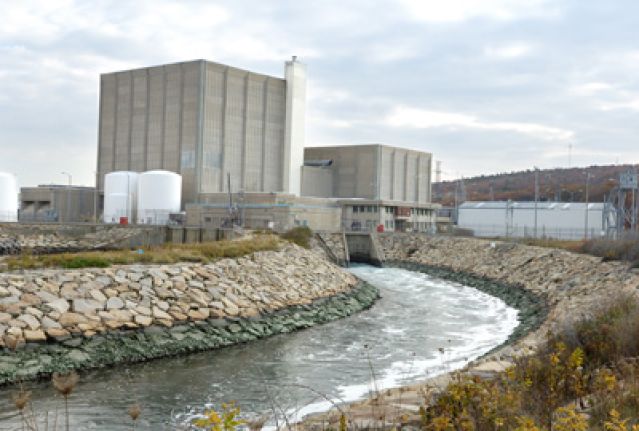Federal regulators from the Nuclear Regulatory Commission launched a three-week safety inspection of the long-troubled Pilgrim nuclear power plant on Monday.
A team of about 20 people will carry out the “top-to-bottom” review that will focus on human performance, equipment reliability and safety culture, according to the commission.
The Pilgrim plant has been under increased oversight since September 2015, when an inspection found safety issues that downgraded the power plant to Column 4 on the Nuclear Regulatory Commission’s (NRC) Action Matrix Summary, also called the “Degraded Cornerstone Column.” “What we do when a plant is in Column 4 is conduct intensive inspections to ensure that the underlying performance issues are addressed and that there aren’t other issues that haven’t exhibited themselves,” said Diane Screnci, senior public affairs officer for the NRC’s Region 1. “At Pilgrim, we’re doing it in three parts. This is the third part and largest of the inspections.” Screnci said that the issues that prompted Pilgrim to be downgraded were of “low to moderate” safety concerns, but its failure to fix them in a timely matter resulted in the downgrade and pushed NRC to take this lasting action. Entergy Corp., the Louisiana-based operator which owns the Pilgrim plant, announced last year that it is closing the plant by June 1, 2019 because of “poor market conditions.” Because Pilgrim plans to refuel and continue to provide nuclear power until that date, the NRC will continue to regulate and inspect the plant. “The economics simply do not support continued operation,” the company said when it first announced the plant would close. “Pilgrim’s revenues continue to be significantly impacted by low wholesale energy prices driven by historically low natural gas prices. We made a commitment to serve as a capacity resource for the region until 2019.” The current inspection is the “next step in Pilgrim’s process toward a return to industry excellence,” said Entergy spokesperson Patrick O’Brien in a news release. “We have worked hard to address the issues that led to station performance decline and look forward to demonstrating to the NRC that we have made significant progress in these areas through the inspection process.” O’Brien further clarified that though the plant still plans to close in 2019, Pilgrim hopes to return to “Column 1,” or regular oversight status.
The permanent shutdown of Pilgrim won’t be a complicated or unsafe procedure because plants often shut down while operating, whether to refuel or to investigate a concern, according to the NRC. By June 1, 2019 — a date decided by Entergy — the reactors will be turned off and the remaining fuel removed. Pilgrim will then have up to 60 years to complete its “decommissioning,” meaning the full cleanup of radioactivity from concrete or buildings. That long time frame has to do with how radioactivity decays, Screnci explained, but she said that the process can be completed more quickly than that. While the NRC said that Pilgrim’s violations weren’t serious enough to cause intense safety concerns, watchdog groups and community residents have spoken out against the plant. There are only three reactors that require this high level of oversight from the NRC — Pilgrim and a two-unit plant in Arkansas — and Entergy owns all three. “Time and time again if you look at what went wrong this year, there’s a common thread: The equipment was supposed to have been replaced and fixed when it was identified a year or so ago, but it was never attended to,” said Mary Lampert of the watchdog group PilgrimWatch. “You could say [it’s] mismanagment, putting off any expense in the hopes that it won’t break before Pilgrim closes in 2019 or a policy of ‘don’t bother fixing it until it breaks.'” Lampert said that that is a “bad policy” for a nuclear reactor when there are such grave consequences if something goes wrong.
Lampert recently contacted the NRC and Gov. Charlie Baker’s office to request that Baker appoint an independent engineer to accompany the NRC inspectors in order to better represent the interests of the public. Screnci confirmed that the Massachusetts State Liaison Officer, John Giarrusso, who is appointed by the governor to be the main contact with the NRC, is onsite during this inspection. Screnci also said that the NRC is unbiased in its investigations. That doesn’t fully satisfy some watchdogs, however. Heather Lightner, president of Concerned Neighbors of Pilgrim, said that Giarrusso is not a nuclear engineer and that Lampert and the other groups who expressed concerns were hoping for an objective nuclear engineer with extensive experience in boiling water reactors (which Pilgrim is) to join the inspection. “The concerns of the public must be properly addressed as it bears the economic, environmental, health and safety liabilities associated with Pilgrim’s operations,” Lightner said. “An ill-repaired and malfunctioning Pilgrim plant poses a threat to the entire state; it’s a shame that we lost the opportunity to ensure a truly independent and quality inspection, especially at this critical time.”
Federal regulators launch 3-week safety inspection of Pilgrim nuclear power plant

File























